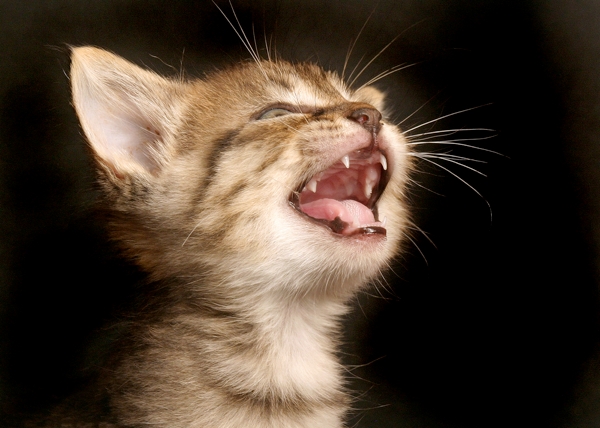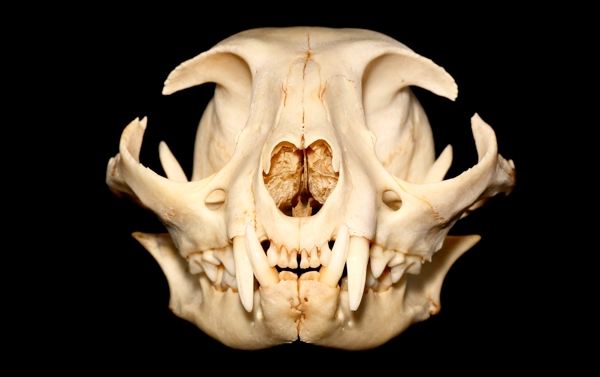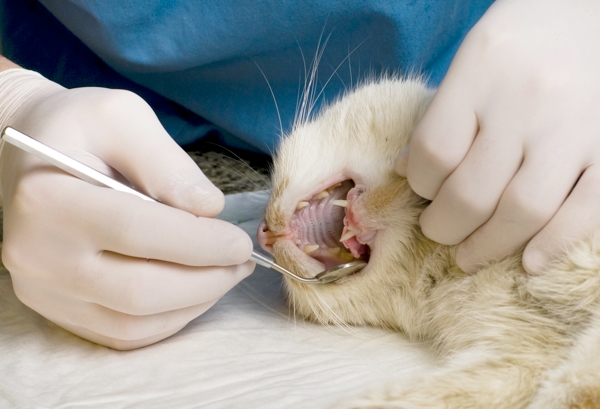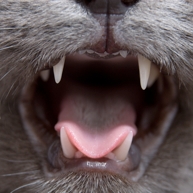Editor’s note: February is National Pet Dental Health Month, an ideal time to republish this post so you can get the information and comment on it.
Cats’ teeth have always fascinated me. It’s hard to imagine that a creature so gentle could have such harrowing-looking choppers. But it’s really all about the way the cat evolved. Here are a few things you might not have known about your cat’s teeth.

1. A kitten’s age can be determined by her teeth
Like humans, cats have two different sets of teeth. A set of 26 "baby teeth," or deciduous teeth in veterinary terminology, start coming in between the ages of two and four weeks. Between the ages of three and four months, the adult teeth come in. When all is said and done, adult cats have 30 teeth.
2. Cats’ teeth are built for eating meat
Unlike the molars of humans and herbivorous animals like cows and horses, cats’ molars don’t have flat surfaces designed for grinding grains and other vegetable matter. They use their sharp, serrated molars to shear muscle and connective tissue off the bones and cut them up into chunks they can swallow whole. Cats can only move their jaws up and down, whereas we humans can move our jaws from side to side — another reason why cats can’t chew up a nice salad.

3. Cats use their front teeth mainly for grooming
Cats’ incisors — or as I like to call them, tiny little nibble-teeth — are perfect grooming accessories. With their incisors, cats can catch fleas crawling around in their fur and swallow them whole, for example. The incisors can also be helpful for working mats out of the fur and removing stray plant material after a walk in the field.
4. Cats get cavities, too, but you don’t see them
When humans get cavities, they usually start on the chewing surface of the tooth and the decay works its way inward. But cat cavities, more accurately known as resorptive lesions, generally start at the neck of the tooth, under the gum line. Most of the time, people aren’t aware that their cats have cavities until they notice a missing tooth.

5. Cat cavities are as painful as human cavities
Although cats’ instincts drive them not to show pain, that doesn’t mean they don’t feel it. If you’ve ever lost a filling, broken a tooth, or had a deep cavity or dental abscess, you know how much it hurts. Cats experience that same level of agony when they develop severe dental problems. If for no other reason than to keep your cat from suffering unnecessarily, please make sure your cat has regular checkups and dental cleanings when your vet recommends it.
Do you know any other interesting facts about kitty teeth? Have you had your cat’s teeth professionally cleaned? Do you brush your cat’s teeth? Please share your responses in the comments!
Read more about cats and dental health on Catster:
- Why Are Cats Anesthetized for Routine Dental Work?
- 5 Signs That Your Cat Has Dental Disease
- 5 Reasons Having Your Cat’s Teeth Cleaned Is Worth the Cost?
About JaneA Kelley: Punk-rock cat mom, science nerd, animal shelter volunteer and all-around geek with a passion for bad puns, intelligent conversation, and role-play adventure games. She gratefully and gracefully accepts her status as chief cat slave for her family of feline bloggers, who have been writing their award-winning cat advice blog, Paws and Effect, since 2003.








